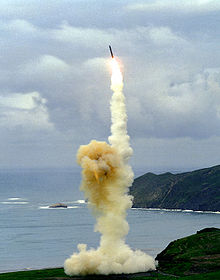
The LGM-30 Minuteman is a U.S. land-based intercontinental ballistic missile (ICBM), in service with the Air Force Global Strike Command. As of 2016, the LGM-30G Minuteman III version is the only land-based ICBM in service in the United States.
Development of the Minuteman began in the mid-1950s as the outgrowth of basic research into solid fuel rocket motors which indicated an ICBM based on solids was possible. Such a missile could stand ready for extended periods of time with little maintenance, and then launch on command. In comparison, existing U.S. missile designs using liquid fuels required a lengthy fueling process immediately before launch, which left them open to the possibility of surprise attack. This potential for immediate launch gave the missile its name; like the Revolutionary War's Minutemen, the Minuteman was designed to be launched on a moment's notice.
Minuteman entered service in 1962 as a weapon tasked primarily with the deterrence role, threatening Soviet cities with a counterattack if the U.S. was attacked. However, with the development of the U.S. Navy's Polaris which addressed the same role, the Air Force began to modify Minuteman into a weapon with much greater accuracy with the specific intent of allowing it to attack hardened military targets, including Soviet missile silos. The Minuteman-II entered service in 1965 with a host of upgrades to improve its accuracy and survivability in the face of an anti-ballistic missile (ABM) system the Soviets were known to be developing. Minuteman-III followed in 1970, using three smaller warheads instead of one large one, which made it very difficult to attack by an anti-ballistic missile system which would have to hit all three widely separated warheads to be effective. Minuteman-III was the first multiple independently targetable reentry vehicle (MIRV) ICBM to be deployed. Each missile can carry up to three nuclear warheads, which have a yield in the range of 300 to 500 kilotons.